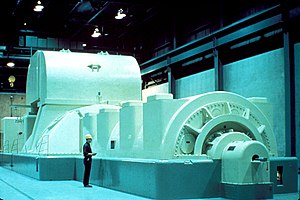Terminology and History
– Electromagnetic generators can be classified as dynamos or alternators.
– Dynamos generate pulsing direct current through a commutator.
– Alternators generate alternating current.
– A generator consists of a rotor and a stator, which form a magnetic circuit.
– The magnetic field can be produced by field windings or permanent magnets.
– Before the discovery of the connection between magnetism and electricity, electrostatic generators were invented.
– Electrostatic generators operated on electrostatic principles, generating high voltage and low current.
– The first electromagnetic generator, the Faraday disk, was invented by Michael Faraday in 1831.
– The Faraday disk was inefficient and had low power output.
– Later designs of homopolar generators solved the efficiency and power output issues.
– Ányos Jedlik independently experimented with electromagnetic rotating devices.
– He discovered the self-excitation phenomenon, which replaced permanent magnet designs.
– Jedlik may have formulated the concept of the dynamo before Siemens and Wheatstone.
– He did not patent his discoveries, believing he was not the first to realize them.
– Jedlik’s work contributed to the development of dynamos.
– Early electric generators produced alternating current (AC), but many applications required direct current (DC).
– Dynamos converted AC into DC using a commutator.
– The commutator reversed the connection of the armature winding, creating a pulsing DC current.
– The first practical dynamo was built by Hippolyte Pixii in 1832.
– The modern dynamo, suitable for industrial use, was independently invented by Wheatstone, Siemens, and Varley.
Faraday Disk Generator and Self-excitation
– The Faraday disk was the first electric generator.
– It consisted of a horseshoe-shaped magnet and a rotating copper disc.
– The rotating disc induced an electric current radially outward from the center to the rim.
– The Faraday disk produced a small DC voltage.
– Later designs used multiple turns of wire in a coil to increase the voltage output.
– Diverting power to an electromagnetic field coil increased generator power.
– Field coils connected in series or parallel with the armature winding.
– Remanent magnetism in the iron core provides initial magnetic field.
– Bootstrap process continues until the generator reaches steady-state power output.
– Very large power station generators may use a separate smaller generator for excitation.
Types of Generators
– Dynamos use commutators to produce direct current.
– Homopolar generators generate DC using a rotating conductive disc or cylinder.
– Homopolar generators can produce tremendous electric current.
– Magnetohydrodynamic (MHD) generators extract power from moving hot gases.
– MHD generators were developed for steam power plants.
– Induction AC motors can be used as generators.
– Induction generators operate by turning their rotor faster than synchronous speed.
– Induction generators are useful in minihydro power plants and wind turbines.
– They do not require another circuit to start working.
– Induction generators can recover energy with relatively simple controls.
– Synchronous generators operate at the connected grid frequency.
– Induction generators require a leading voltage to operate.
– Linear electric generators use sliding magnets and solenoids.
– Variable-speed constant-frequency generators regulate output frequency.
– Doubly fed electric machines can regulate frequency over a wider range.
Common Use Cases
– Power stations generate electricity using various energy sources.
– Vehicular generators power motor vehicles, bicycles, sailboats, RVs, and electric scooters.
– Gensets combine an electrical generator and an engine for independent power supply.
– Human-powered generators can be used to charge batteries.
– Tachogenerators measure shaft speed in mechanical systems.
Power Stations and Other Applications
– Power stations generate electricity using generators.
– Most power stations burn fossil fuels, but cleaner sources like nuclear power and renewables are increasingly used.
– Power stations contain one or more spinning machines converting mechanical power into electrical power.
– The relative motion between a magnetic field and a conductor creates an electric current.
– Power stations are also known as power plants, powerhouses, or generating stations.
– Motor vehicles use alternators with built-in rectifier circuits.
– Bicycles can have bottle dynamos or hub dynamos to power lights and equipment.
– Sailboats use water- or wind-powered generators to trickle-charge batteries.
– Recreational vehicles require an extra power supply for onboard accessories.
– Electric scooters with regenerative braking can recover energy and increase range.
– Engine-generators combine an electrical generator and an engine.
– Engines used can be piston engines, gas turbines, or hybrid diesel-gas units.
– Engine-generators can independently supply electricity as backup power sources.
– Different versions of engine-generators are available, from portable to large turbine installations.
– Engine-generators are also known as gensets or dual-fuel units.
– Use of generators in off-grid living for campers and RVs.
– Power generators for hurricane preparedness.
– Wall Street protesters using bicycle power.
– Generators in the field of large turbo-generator operation and maintenance.
– Yoshihide Hase’s book on Power System Engineering and generators. Source: https://en.wikipedia.org/wiki/Electrical_generator
In electricity generation, a generator is a device that converts motion-based power (potential and kinetic energy) or fuel-based power (chemical energy) into electric power for use in an external circuit. Sources of mechanical energy include steam turbines, gas turbines, water turbines, internal combustion engines, wind turbines and even hand cranks. The first electromagnetic generator, the Faraday disk, was invented in 1831 by British scientist Michael Faraday. Generators provide nearly all the power for electrical grids.

In addition to electricity- and motion-based designs, photovoltaic and fuel cell powered generators use solar power and hydrogen-based fuels, respectively, to generate electrical output.
The reverse conversion of electrical energy into mechanical energy is done by an electric motor, and motors and generators are very similar. Many motors can generate electricity from mechanical energy.
